Covid vaccines being used in Britain are working ‘spectacularly well’ at slashing hospital admissions in Scotland and preventing even mild infections among health workers in England, the first real-world data revealed today.
Public Health England and top researchers in Scotland have published two separate papers linking up coronavirus data with vaccinations, revealing that jabs are both bringing down hospital admissions and preventing infections.
A single dose of Pfizer’s vaccine can cut the risk of testing positive with or without symptoms by 70 per cent, PHE found, rising to 85 per cent after a second jab.
And a dose of either Pfizer and AstraZeneca reduces someone’s risk of developing Covid severe enough to need hospital treatment by between 85 and 94 per cent, according to a separate study in Scotland.
PHE’s study showed that the Pfizer jab gave 57 per cent protection against Covid among over-80s from dose one, and this appeared to rise to 88 per cent after a second jab, although this data is preliminary. There was not enough information to make the same analysis for Oxford/AstraZeneca’s jab.
Experts dubbed the findings ‘very encouraging’, ‘a good sign’ and ‘reasons to be optimistic’ – they come as Boris Johnson today outlines Britain’s route out of lockdown, with schools expected to properly reopen in England from March 8, with further measures being loosened in the following weeks.
Government advisers on SAGE are still cautious, warning that 94 per cent protection ‘is not 100 per cent’ and that millions will still be at risk of Covid even with high vaccine coverage.
More than 17.5million people in the UK have had at least one dose of a coronavirus vaccine and vaccines minister Nadhim Zahawi said on Sky News today: ‘We wouldn’t be in this place this morning to be able to say that we’re going to reopen schools on March 8… if we’re not confident that, actually, the vaccine programme is beginning to really bear fruit.’

Out of 23,324 health workers in the study, 89 per cent were vaccinated by February 5. There were 977 cases of coronavirus recorded in people before they were vaccinated, compared to 71 among people who were three weeks post-vaccination, PHE’s Dr Susan Hopkins said today
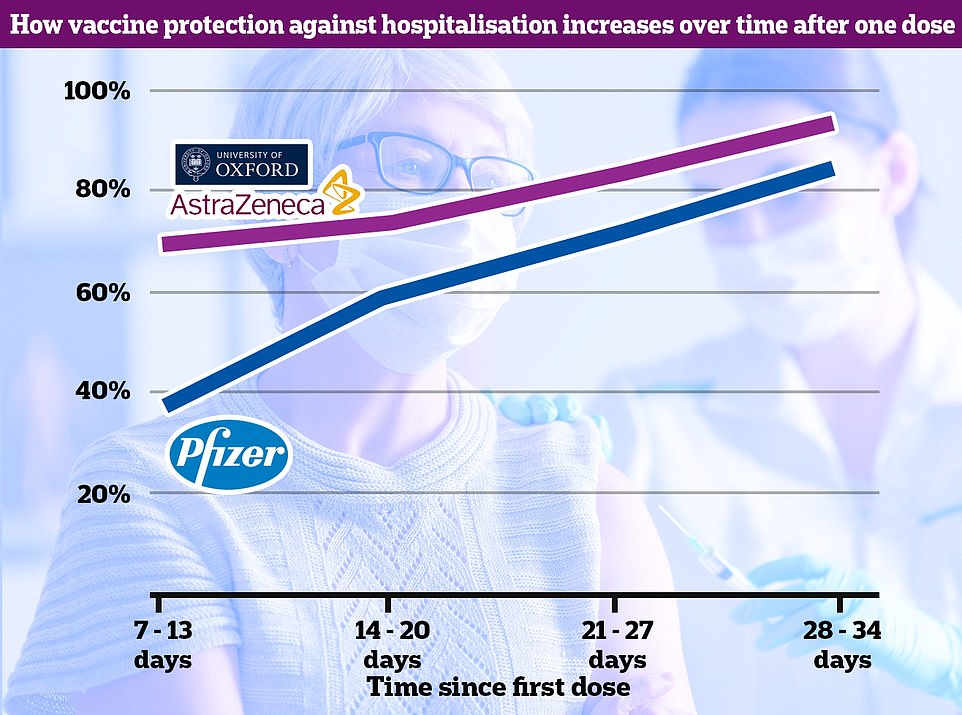
The Scottish study showed that both vaccines offer a high level of protection against being hospitalised with Covid from just two weeks after a single dose, with the protection kicking in only a week after injection. There were not enough data to compare the two, the scientists said, although AstraZeneca’s appears to work better in the early stages
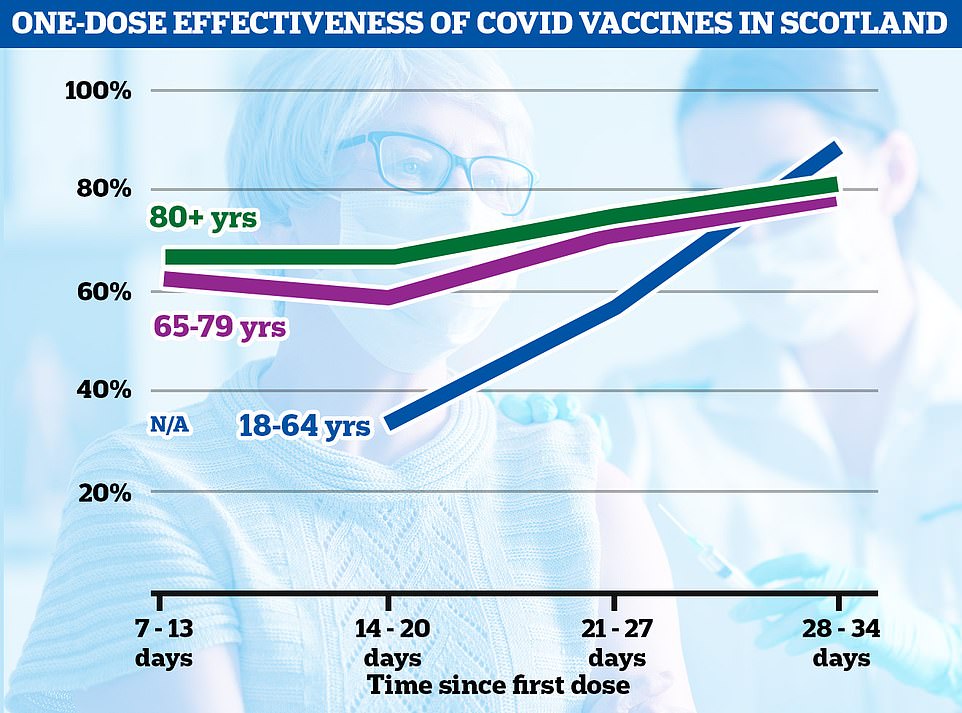
In a ray of hope for Britain’s lockdown-easing plans, results showed the jabs slashed the risk of hospital admission from Covid by up to 85 and 94 per cent, respectively, four weeks after the first dose. The graph above shows how the vaccine worked in different age groups
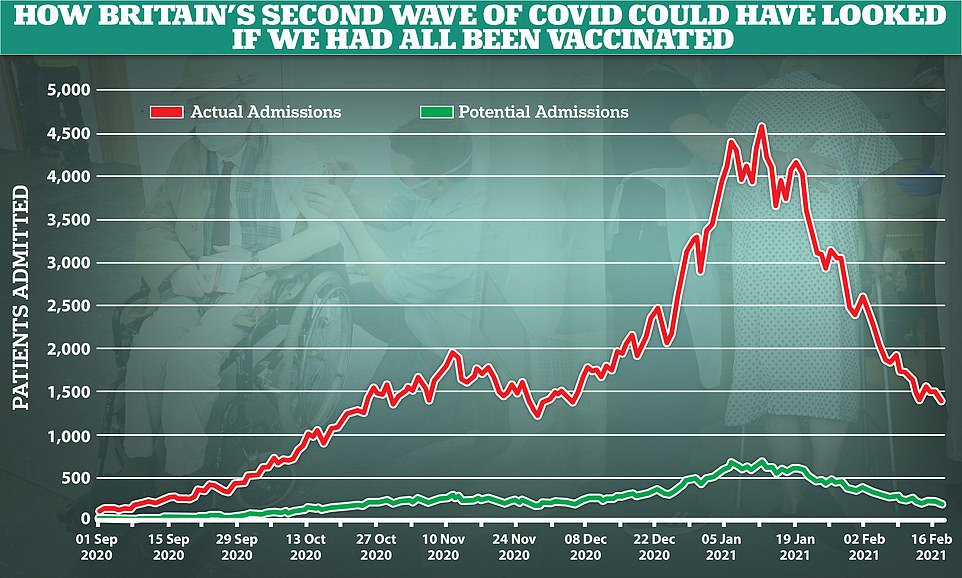
For illustrative purposes, an 85 per cent reduction in the risk of hospitalisation could have meant that, if the UK’s entire adult population were vaccinated before the second wave, the 4,576 new coronavirus-related hospital admissions at the peak on January 12 could have been just 690 – 15 per cent of the total
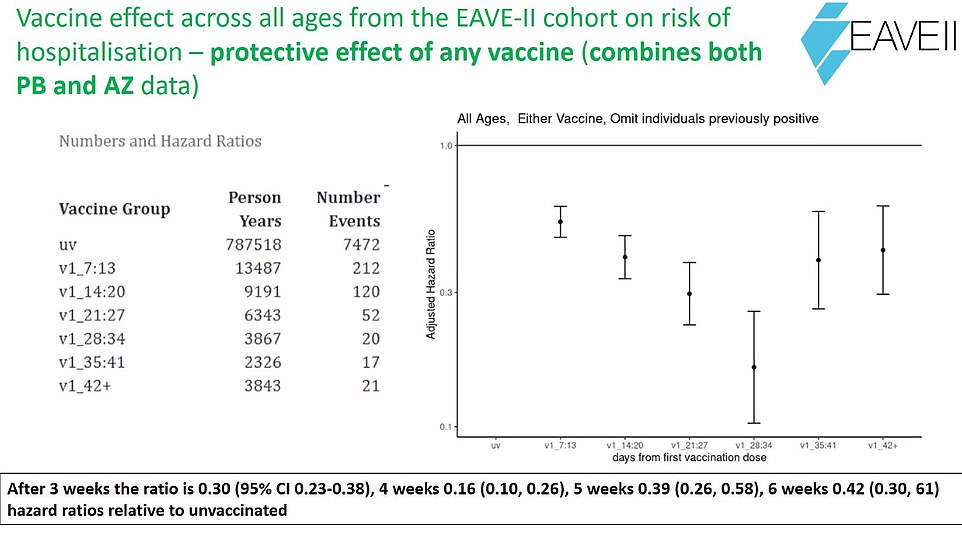
Results showed the jabs slashed the risk of hospital admission from Covid by up to 85 and 94 per cent, respectively, four weeks after the first dose. Experts insist the risks only appear to wear off after four weeks because of a lack of data — not because immunity wears off
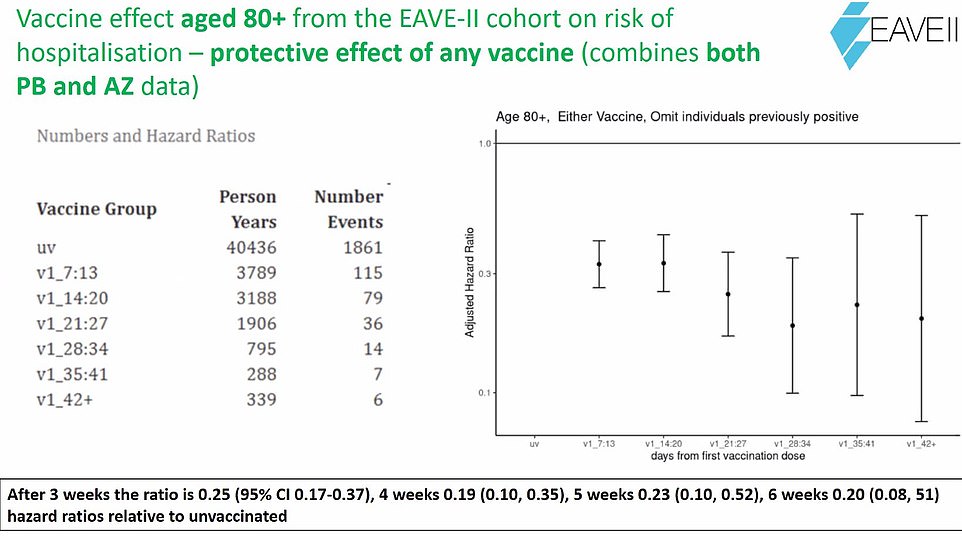
It showed that among those aged 80 and over — one of the highest risk groups — vaccination was associated with an 81 per cent reduction in hospitalisation risk in the fourth week, when the results for both vaccines were combined. Researchers presented their findings as hazard ratios, with a figure of 0.19 converting to an 81 per cent risk reduction. For comparison, a figure of 1.19 would have meant a 19 per cent increase in risk
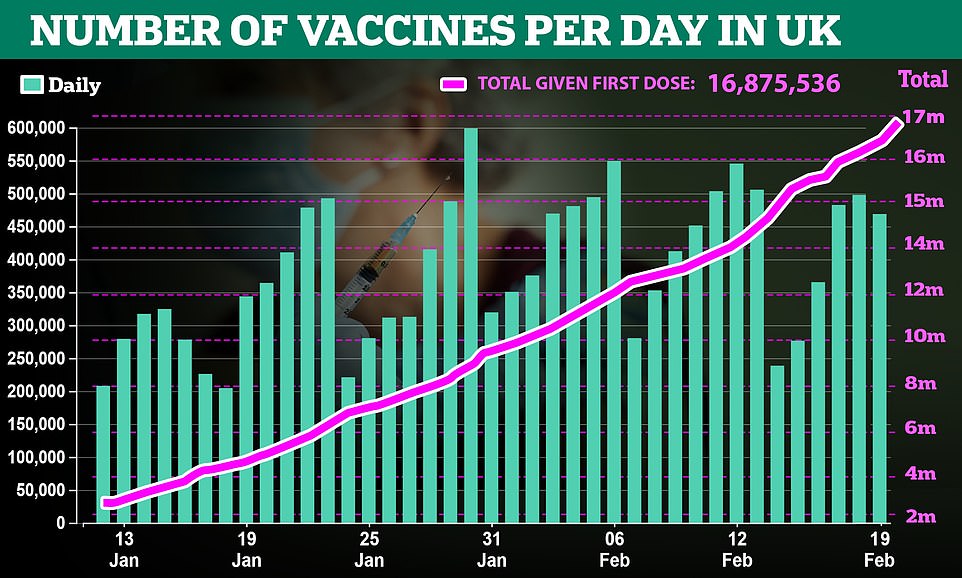
Public Health England today published the results of its SIREN study, which looks at how coronavirus is affecting medical workers across the country.
Medical staff have been among the top priority groups for vaccinations and also at a high risk of catching the virus during the second wave, so they are an extremely useful group for studying the effectiveness of the jabs.
Out of 23,324 health workers in the study, 89 per cent were vaccinated by February 5. There were 977 cases of coronavirus recorded in people before they were vaccinated, compared to 71 among people who were three weeks post-vaccination, PHE’s Dr Susan Hopkins said today. A further nine tested positive within a week of the jab.
The PHE epidemiologist told a news briefing: ‘Overall we’re seeing a really strong effect at reducing any infection.’
The study summarised the protection against coronavirus infection of any severity to be ‘at least 70 per cent 21 days after the first dose, increasing to at least 85 per cent 7 days after the second dose.’
Preventing people from testing positive for the disease almost certainly means that the vaccines will stop transmission, which is a boon for the Government’s plans to end lockdown this summer.
Clinical trials had not studied this before, instead looking only at symptomatic infection, hospital admissions or deaths. These are most important for preventing people from dying, but stopping the virus spreading is crucial for returning life to normal.
PHE also published separate data from a group of 148,052 over-70s showing that the vaccine protects elderly people (over-80) against Covid-19 symptoms by a factor of 57 per cent three weeks after the first dose. This is then boosted to more than 85 per cent after the second dose.
In all age groups people’s risk of getting such bad Covid that they need to go to hospital drops by over 75 per cent after a single dose of Pfizer’s jab, PHE said. For over-80s there is a 40 per cent reduction.
And the risk of death among people older than 80 is lowered by 56 per cent from two weeks after a first dose of Pfizer’s vaccine.
Dr Mary Ramsay, the head of immunisation at PHE said: ‘This is strong evidence that the Pfizer/BioNTech vaccine is stopping people from getting infected, while also protecting cases against hospitalisation and death.’
She said people should be ‘very encouraged’ by the data but added: ‘Protection is not complete, and we don’t yet know how much these vaccines will reduce the risk of you passing Covid-19 onto others.
‘So even if you have been vaccinated, it is really important that you continue to act like you have the virus, practice good hand hygiene and stay at home.’
PHE’s study comes after research published this morning by Public Health Scotland, the University of Edinburgh and the University of Strathclyde, among others, that showed both Pfizer and Oxford’s jabs are working north of the border.
Using real-world data from members of the public – the first of its kind in the UK – the researchers found that the vaccines led to an 85-94 per cent reduction in hospital admission from four weeks after the first dose.
That study was based on an analysis of data from the 1.14million doses dished out between December 8 and February 15.
It linked up people’s vaccination records to reports of hospital admissions for Covid-19 to see whether people who had had a jab were coming less often than those who hadn’t.
It showed that among those aged 80 and over — one of the highest risk groups — vaccination was associated with an 81 per cent reduction in hospitalisation risk in the fourth week, when the results for both vaccines were combined.
Protection increased over time for both vaccines, from 38 per cent (Pfizer) and 70 per cent (Oxford) after one week – before the jab is expected to work at all – to 85 per cent (Pfizer) and 94 per cent (Oxford) after four weeks.
Oxford’s appeared to be heading towards the almost total protection against severe Covid seen in clinical trials, but the study was not long enough to capture this. Pfizer’s protection was also extremely high and rising.
Professor Aziz Sheikh, the study director from the University of Edinburgh, said: ‘Overall we are very, very impressed with the both the vaccines. When you move beyond the trial settings you never know what the results are going to be.
‘Out in the field… both of these are working spectacularly well.’
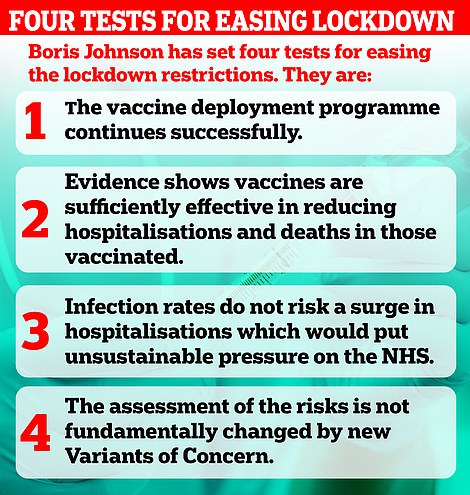
What the results REALLY mean: How Britain’s second wave of Covid COULD have looked if we had all been vaccinated
When it comes to Covid vaccines and whether or not they actually work, scientists have bombarded the public with an array of confusing figures.
Rigorous scientific trials have found some jabs – including the ones being used in Britain – are up to 95 per cent effective at stopping symptomatic illness.
AstraZeneca even bragged that its vaccine offered 100 per cent protection against severe disease, hospitalisation and death, suggesting that no-one given the jab would be hospitalised with coronavirus.
But what these efficacy figures mean in the real-world — where their success rate is actually likely to be much lower — is very different. Efficacy is always higher in controlled studies because researchers use more young and healthy people to make the trials run smoothly and quickly.
For example, an 85 per cent reduction in the risk of hospitalisation from Covid would have a dramatic effect on the NHS. It does not mean your illness is reduced in severity by 85 per cent.
The best way to see the effect of vaccines is by looking at data. Department of Health figures show 4,576 new coronavirus-related hospital admissions were recorded in Britain on January 12.
If the vaccines cut the risk of hospitalisation by the figure seen in the massive Scottish study released today — and were rolled out nationwide before the second wave kicked off, it would have caused the figure to be around 690.
Experts never expected the vaccines to work so well in real-world roll-outs, and say that the proof that a single dose cuts the risk of severe illness so dramatically gives the UK ‘great reasons to be optimistic for the future’.

For illustrative purposes, an 85 per cent reduction in the risk of hospitalisation could have meant that, if the UK’s entire adult population were vaccinated before the second wave, the 4,576 new coronavirus-related hospital admissions at the peak on January 12 could have been just 690 – 15 per cent of the total
Advertisement
And although the study is specific to Scotland, Dr Josie Murray, of Public Health Scotland, said: ‘A lot of this is transferable information that would be applicable across the UK.’
Dr Jim McMenamin, of Public Health Scotland, said: ‘These results are important as we move from expectation to firm evidence of benefit from vaccines.
‘Across the Scottish population the results shown a substantial effect on reducing the risk of admission to hospital from a single dose of vaccine.
‘For anyone offered the vaccine I encourage them to get vaccinated. We are continuing our evaluation and look forward to describing the benefits that we hope will follow the second doses of these vaccines.’
Professor Chris Robertson, an epidemiologist at the University of Strathclyde, said: ‘These early national results give a reason to be more optimistic about the control of the epidemic.
‘They also show the value of linked national data sets with academic research groups working closely with public health institutes.’
But SAGE experts warned in a later briefing today that, although the vaccine results are promising, they are not a silver bullet.
Millions of people will remain vulnerable to the virus if lockdown is lifted too soon, Sir Patrick Vallance warned, even if uptake of the vaccine is high.
Sir Patrick, the chief scientific adviser to the Government, told a briefing the Scotland data were ‘very encouraging’.
But Dame Angela McLean, deputy chief scientific adviser, cautioned: ‘Uptake is not 100 per cent and a 94 per cent reduction in deaths is not 100 per cent. These are fantastic but they’re not perfect.’
Top scientists have so far stuck to cautiously optimistic tones about vaccines, avoiding getting carried away with good news but admitting they expect to see the rollout reduce hospitalisations and deaths ‘any minute now’.
Other experts said last week that they were already seeing ‘early signs’ of their impact on these key measures.
Britain is dishing out almost 400,000 Covid vaccine doses each day, on average, as it races to inoculate the top nine priority groups who are most at risk from the virus.
Almost a third of all adults in the UK have now been vaccinated, at 17.5million.
Mr Zahawi added on BBC Breakfast today that once the over-50s are covered the Government will ‘absolutely’ follow the recommendations of its scientists in expanding the roll-out.
‘The Joint Committee on Vaccination and Immunisation (JCVI) are looking at that and we will absolutely follow what they recommend,’ he said.
‘The recommendation for phase one has been correct because it’s based on clinical assessment of who is most vulnerable to be hospitalised or have serious infection and sadly death in some cases.
‘So we’ll go back to the JCVI and they will make that recommendation and we will follow that recommendation.’
Reports suggest the committee will recommend the drive continues by age groups, meaning over-45s would be next in line.
The Government is confident it has the supplies to vaccinate all adults by July 31 and has pledged to offer first doses to all 32million in the top nine groups by April 15.
It comes as Mr Johnson faced growing Tory backlash today over his ‘cautious’ route out of lockdown, with schools opening on March 8 but precious few other easings until Easter.
The first steps to freedom will prioritise getting children fully back into classrooms in a fortnight’s time, while people may also be able to meet one friend or family member in the park for a coffee or picnic from early March.
But the next stage of loosening will not be until March 29, when the Rule of Six will make a comeback – and be extended to allow two households to gather, enabling relatives to meet properly for the first time in months.
Tennis courts and golf courses will also be allowed to open on this date, along with the return of grassroots football.
Urging caution over framing vaccines as a silver bullet to lift Britain out of lockdown, Public Health Scotland’s Dr Murray added: ‘These data show real promise that the vaccines we have given out can protect us from the severe effects of Covid.
‘We must not be complacent though. We all still need to ensure we stop transmission of the virus, and the best way we can all do this is to follow public health guidance – wash your hands often, keep two metres from others, and if you develop symptoms, isolate and take a test.
‘We also all need to protect ourselves, our families and friends by taking the second dose of vaccine when it is offered.’

Germany and France have vaccinated just six per cent of their populations, while the UK has handed out doses to more than 26 per cent of people
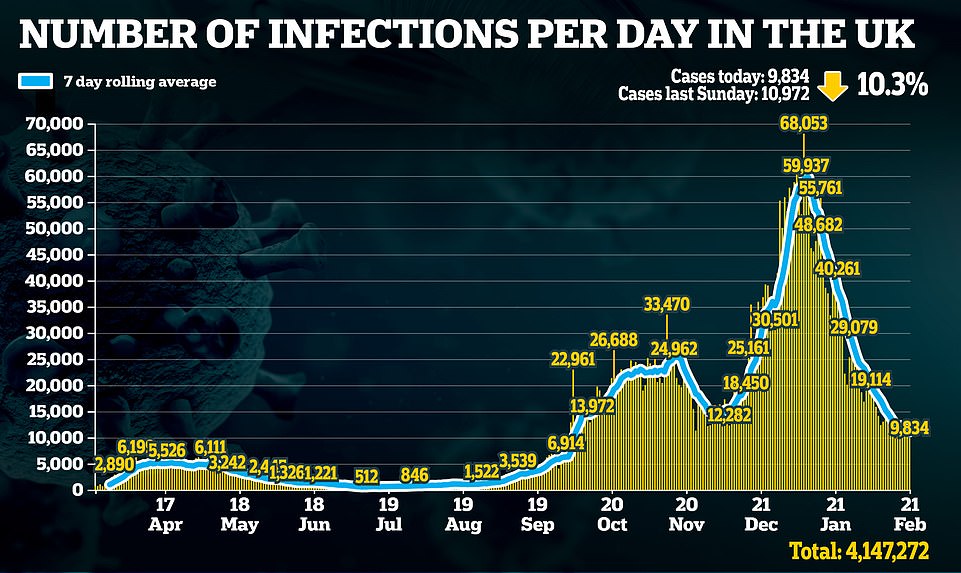

Mr Johnson’s plans for easing lockdown have been bolstered by the latest data whihc shows Covid-19 infection rates have continued to drop, with 9,834 more cases reported – a fall of 10 per cent on last week – while the 215 new daily deaths brought Britain’s total up to 120,580
HOW DO THE UK-APPROVED MODERNA, OXFORD AND PFIZER VACCINES COMPARE?
Moderna and Pfizer/BioNTech have both released interim results of the final stage clinical trials of their vaccines, with both suggesting they are extremely effective.
Oxford University has published the findings from its second phase, which show the jab provokes an immune response and is safe to use – it is not yet clear how well it protects against coronavirus in the real world.
Here’s how they compare:
CREATOR:
MODERNA (US)
PFIZER (US) & BIONTECH (DE)
OXFORD UNIVERSITY (UK)
How it works:
mRNA vaccine – Genetic material from coronavirus is injected to trick immune system into making ‘spike’ proteins and learning how to attack them.
mRNA vaccine – both Moderna’s and Pfizer and BioNTech’s vaccines work in the same way.
Recombinant viral vector vaccine – a harmless cold virus taken from chimpanzees was edited to produce the ‘spike’ proteins and look like the coronavirus.
How well does it work?
94.5% effective (90 positive in placebo group, 5 positive in vaccine group) .
95% effective (160 positive in placebo group, 8 positive in vaccine group).
62% – 90% effective, depending on dosing.
How much does it cost?
Moderna confirmed it will charge countries placing smaller orders, such as the UK’s five million doses, between £24 and £28 per dose. US has secured 100million doses for $1.525billion (£1.16bn), suggesting it will cost $15.25 (£11.57) per dose.
The US will pay $1.95bn (£1.48bn) for the first 100m doses, a cost of $19.50 (£14.80) per dose.
Expected to cost £2.23 per dose. The UK’s full 100m dose supply could amount to just £223million.
Can we get hold of it?
UK has ordered five million doses which will become available from March 2021. Moderna will produce 20m doses this year, expected to stay in the US.
UK has already ordered 40million doses, of which 10million could be available in 2020. First vaccinations expected in December.
UK has already ordered 100million doses and is expected to be first in line to get it once approved.
What side effects does it cause?
Moderna said the vaccine is ‘generally safe and well tolerated’. Most side effects were mild or moderate but included pain, fatigue and headache, which were ‘generally’ short-lived.
Pfizer and BioNTech did not produce a breakdown of side effects but said the Data Monitoring Committee ‘has not reported any serious safety concerns’.
Oxford said there have been no serious safety concerns. Mild side effects have been relatively common in small trials, with many participants reporting that their arm hurt after the jab and they later suffered a headache, exhaustion or muscle pain. More data is being collected.
Advertisement
Source link : https://www.dailymail.co.uk/news/article-9286583/Britains-Covid-vaccines-working-early-studies-show.html











